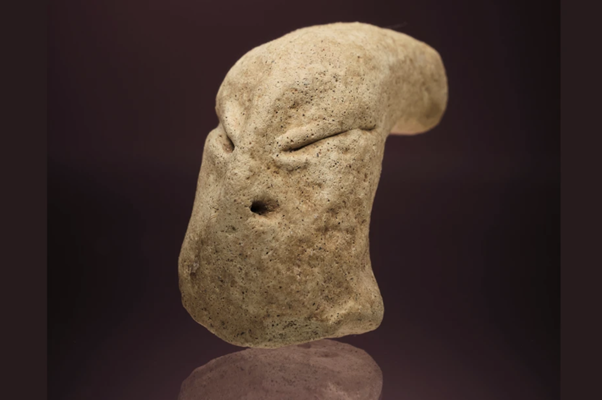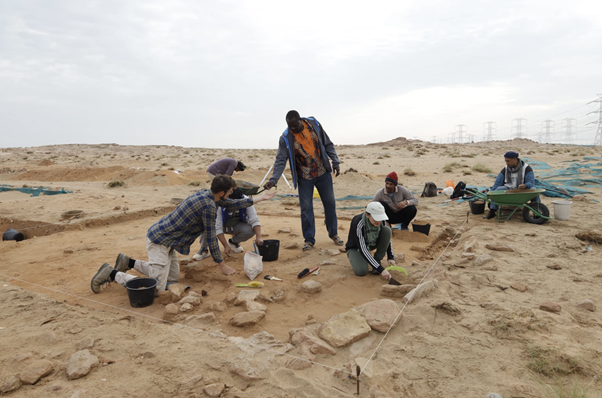A Kuwaiti-Polish archaeological mission conducting excavations in northern Kuwait has uncovered, among other finds, the head of a ceramic figurine dated to 7,000 years ago. Researchers point out that the specific features of the figure depicted on the figurine – an unnaturally elongated skull, slanted eyes, and a flat nose – are characteristic of the prehistoric Ubaid culture. This is the first artifact of its kind discovered in the Persian Gulf region.
The discovery was made at the Bahra 1 archaeological site, which has been studied since 2009 by a team led by the Kuwaiti National Council for Culture, Arts, and Letters (NCCAL) in collaboration with the Polish Centre of Mediterranean Archaeology at the University of Warsaw (PCMA UW). Bahra 1, dated to the mid-6th millennium BCE, is one of the oldest and largest known settlements on the Arabian Peninsula. This year’s excavation season was led by Dr Agnieszka Pieńkowska from the Polish Centre of Mediterranean Archaeology (PCMA UW).
Elongated skull and symbolic meaning: what do we know about the figurine?
The carefully crafted figurine has not survived intact – despite extensive searches, archaeologists were unable to find its torso, making it also difficult to determine the gender of the figure it represents. Additionally, researchers hypothesise that the figurine may have originally worn a “wig” made from a different material.
Agnieszka Szymczak from the Polish Centre of Mediterranean Archaeology at the University of Warsaw, a member of the expedition, suggests that the elongated shape of the skull may have had not only a practical purpose, such as facilitating the attachment of the aforementioned “wig,” but also symbolic significance. Analyses of human remains from that period indicate that deliberate cranial modifications were practiced. This process involved binding the heads of infants to elongate the forehead and upper part of the skull. However, this was not a widespread custom.
The figurine’s purpose, however, remains unclear. “The presence of this figurine at our site poses fascinating questions regarding its function and the symbolic, or perhaps ritual, significance it might have held for the community that inhabited this settlement,” remarked Professor Piotr Bieliński from the University of Warsaw, co-leader of the Polish team on the expedition.
According to Agnieszka Szymczak, the location where the figurine was found was unlikely to have been a place of worship. Instead, it was situated outside the main settlement area, where various activities took place, such as food preparation, shell processing, and the operation of a bead-making workshop.
“At the same time, a relatively large number of items that could have served as small personal ornaments were found there, and such objects in prehistoric communities (and beyond) often hold strong symbolic significance,” Szymczak explained in an interview with National Geographic Polska.

The figurine /Fot. Adam Oleksiak /CAŚ UW
The significance of the Ubaid culture
The enigmatic figurine was not created by the local community; it was brought from the Mesopotamian region, approximately 200–300 km away from Bahra 1. Archaeologists have identified complete examples of similar works of art.
According to researchers from the University of Warsaw, excavations at the Bahra 1 site provide insights into the cultural exchange between Neolithic communities of Arabia and the Ubaid culture, which originated in Mesopotamia and spread across a vast area, from Anatolia to the Arabian Peninsula.
The Ubaid culture, dated to 6200–3800 BCE, was a pivotal stage in the development of Mesopotamia. It was characterised by advancements in architecture, economy, and social structures. The construction of rectangular mudbrick houses, the development of temples, and the intensification of irrigated agriculture indicate a growing level of social and technological organisation.
Distinctive ceramics and anthropomorphic figurines point to the development of aesthetics and symbolism, while the culture’s reach, encompassing Mesopotamia, Anatolia, and the Persian Gulf, reflects extensive trade networks and cultural interactions.
The mysteries of the Bahra 1 site
In 2024, archaeologists at the Bahra 1 site discovered an unfired clay vessel, confirming local ceramic production. Two types of pottery were found at Bahra 1: imported Ubaid culture ceramics, noted for their precision and decorative features, and the so-called Coarse Red Ware – thick-walled, simpler red pottery also identified at other archaeological sites across the Arabian Peninsula.
Analyses conducted by Dr Anna Smogorzewska revealed that Bahra 1 is the oldest known site of production for this second type of pottery in the Persian Gulf region, confirming its local origins.
The figurine /Fot. Adam Oleksiak /CAŚ UW

Excavations in Kuwait / Fot. M. Antos/CAŚ UW
More:
- Bahra 1 (UW)
- Odkrycie prehistorycznej figurki (UW)
- Wygląda jak nie z tego świata. Polscy archeolodzy odkryli w Kuwejcie zagadkową figurkę sprzed ponad 7 tys. Lat (National Geographic)
- Polacy dokonali sensacyjnego znaleziska. Pochodzi sprzed 7500 lat (Wprost)


